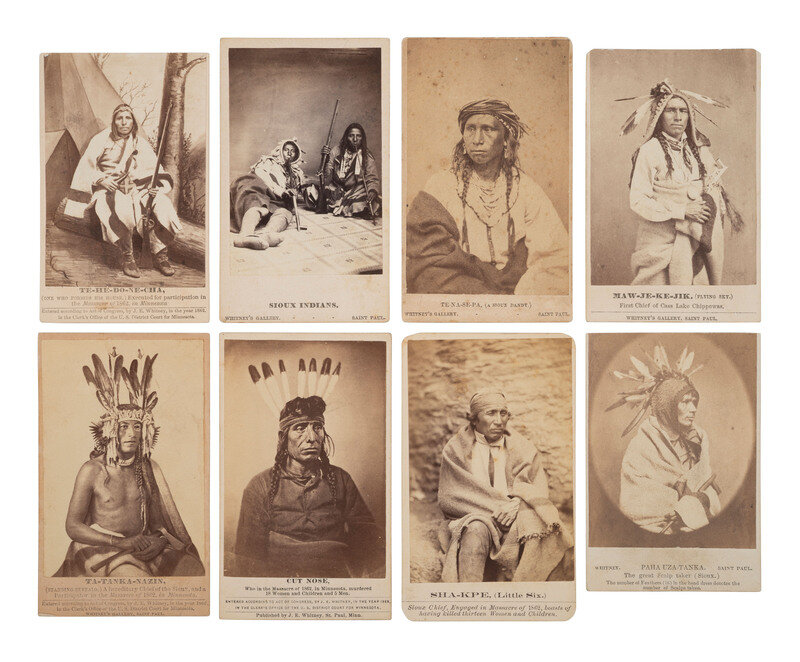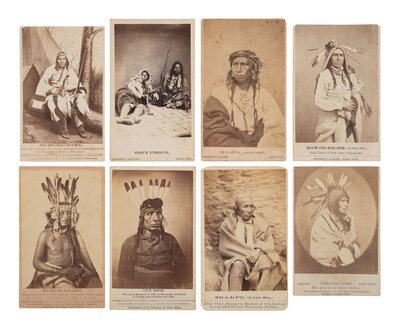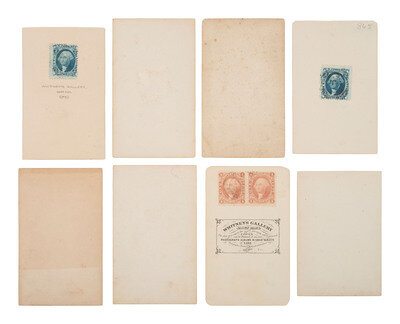Condition Report
Contact Information
Auction Specialist
Lot 226
Sale 6425 - American Historical Ephemera and Early Photography, including The Larry Ness Collection of Native American Photography
Part I - Lots 1-222
Oct 23, 2025
10:00AM ET
Part II - Lots 223-376
Oct 24, 2025
10:00AM ET
Live / Cincinnati
Own a similar item?
Estimate
$1,000 -
1,500
Price Realized
$1,080
Sold prices are inclusive of Buyer’s Premium
Lot Description
A group of 8 CDVs of Sioux involved in the 1862 Dakota Uprising in Minnesota incl. executed subjects. St. Paul, MN: Whitney's Gallery.
8 CDVs on cardstock mounts credited to Whitney's Gallery, St. Paul, MN. The subjects, identified on rectos, include:
Te-He-Do-Ne-Cha, aka One Who Forbids His House. Possibly 2 views, including the individual portrait and a portrait of two young men identified as "Sioux Indians." Research suggests that one of the subjects may be One Who Forbids His House. -- Te-Na-Se-Pa, aka A Sioux Dandy. -- Sha-Kpe, aka Little Six. -- Ta-Tanka-Nazin, aka Standing Buffalo. -- Cut Nose. -- Paha Uza-Tanka, aka The Great Scalp Taker. -- Maw-Je-Ke-Jik, aka Flying Sky.
The new state of Minnesota was home to thousands of Native Americans in 1862, many of whom were disenchanted with the government's promise for annuities. In August of that year, a number of the Dakota were starving; on the 18th, Indians at the Lower Agency attacked the white settlers there. Over the next few weeks hundreds of whites were killed, until the uprising was finally put down by Federal troops under the command of Henry Sibley. Whitney photographed a number of the Native American principals involved with the uprising.
Thirty-eight Dakota prisoners of war were hanged at the same time on a massive scaffold in the largest public execution in U.S. history, at Mankato, Minnesota, December 26, 1862. More than 300 Dakota participants in the uprising of August 1862, had been tried and condemned by military tribunals, but most were spared by order of President Lincoln. Nearly all of the Dakota people were deported to Dakota Territory, at Crow Creek Reservation on the Missouri River, where many died of starvation and disease during the following three years. In 1866, the survivors were moved downriver to Santee, Nebraska, where their descendants remain.
Joel Ellis Whitney (1822-1886) is considered Minnesota's finest pioneer photographer. He successfully operated his business in St. Paul during the years 1851-1871, before selling his studio and negatives to Charles Zimmerman, who in turn became the most prominent photographer in the state.
The Larry Ness Collection of Native American Photography
This lot is located in Cincinnati.



